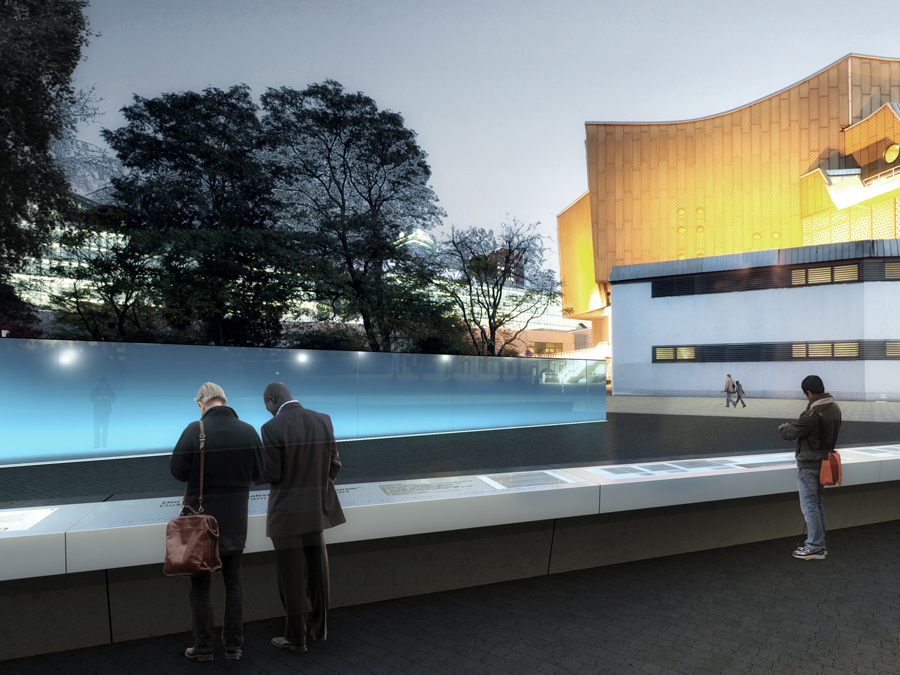TUM historians develop content for the Memorial and Information Point for the Victims of National Socialist “Euthanasia” Killings
Remembrance means to commemorate and to inform

In November 2011, the German Bundestag resolved to erect a memorial and information point for the approximately 300,000 victims of the “euthanasia” killings at the site of the former center for the planning of the National Socialist “euthanasia” campaign in Tiergartenstraße 4 in Berlin. The victims of “euthanasia” and forced sterilization had long been among the forgotten victims of the National Socialist regime. Thanks to the new memorial and information point, which was designed by a group of architects led by Ursula Wilms, they are now a focus of public commemoration.
The historical content, texts, and contributions for the open-air exhibition’s media stations were developed by a team led by PD Dr. Gerrit Hohendorf from the Institute for History and Ethics of Medicine at TUM and PD Dr. Maike Rotzoll from the University of Heidelberg. This work was carried out as part of a two-year knowledge transfer project, for which the DFG provided approximately 300,000 euros in funding. Some of the researchers had already completed two years’ work on historical analysis of the 3,000 medical files of the victims of the “euthanasia” killings. The information obtained from this research was incorporated into the new DFG project “Remembrance means to commemorate and to inform: The Nazi ‘euthanasia’ program and the historic site at Tiergartenstraße 4 in Berlin,” which is being carried out in cooperation with the Foundation Memorial to the Murdered Jews of Europe and the Topography of Terror Foundation.
Back in May 2013, the researchers met with relatives of the victims, representatives of victim initiatives, and historians at a workshop that was organized with a view to developing the exhibition concept. Together, they explored the limits and scope of the ways in which the historical information can be presented at this authentic location, where the first mass extermination campaign carried out in the name of National Socialism was planned and organized.
The aim is to facilitate access to the exhibition for people with disabilities and learning difficulties in particular. This is achieved through the presentation of the exhibition texts in clear and easily understood language; media stations are also provided that include tools for people with visual and hearing impairments. “It is important that the historical information be made accessible and understandable for the groups that could have been victims of the extermination program during the Nazi period,” explains Hohendorf.
Ten typical victim biographies
The victims’ fates are stories of social exclusion, which began before 1933 in many cases and ended with physical extermination. The focus of the exhibition is the administrative center of the “euthanasia” program, which was based in an urban villa in Tiergartenstraße 4 in Berlin: it was here that the information sheets about the patients to be selected for extermination were compiled, the transport to the extermination centers was organized, and the bureaucratic processing of the killings was carried out.
The researchers selected ten typical victim biographies to structure the exhibition and commemorate very different fates. The victims in question include 87-year-old coachman Karl Ahrendt, who had been detained in Berlin sanatoriums and asylums from 1907 and was gassed at the Bernburg “euthanasia” killing center in 1941, and 15-year-old Wilhelmine Haußner from Munich, who was killed by medical overdose at a so-called “special children’s ward” (Kinderfachabteilung) in 1942. The murdered persons with mental illnesses and learning difficulties were classified as “incurable” and individuals “unworthy of life” by the National Socialist state.
Although the killings by gassing organized in Tiergartenstraße 4 (“Action T4”) came to an end in August 1941 following protests by the churches and general public, the killings in the sanatoriums and asylums, carried out through the systematic withdrawal of food, neglect and medical overdose, continued until 1945. Including the murders of psychiatric patients in the occupied areas of Poland and the Soviet Union, the National Socialist “euthanasia” killing program claimed a total of around 300,000 victims. After decades of suppression and secrecy – in the context of psychiatry, society, and the law – the people murdered under this program will now be commemorated at a central location in Berlin.
The following researchers are involved in the knowledge transfer project “Remembrance means to commemorate and to inform,” which continues until early 2015 with the compilation of the catalogues and online presentation: Dr. Christof Beyer (TUM), Dr. Petra Fuchs (Berlin), Dr. Annette Hinz-Wessels (TUM), PD Dr. Gerrit Hohendorf (TUM), PD Dr. Maike Rotzoll (Institute for History and Ethics of Medicine, University of Heidelberg), Jens Thiel (TUM).
Contact:
PD Dr. Gerrit Hohendorf
Institute for History and Ethics of Medicine
Klinikum rechts der Isar der Technischen Universität München
hohendorf@gesch.med.tum.de
Phone: + 49 89 4140-4041
PD Dr. Hohendorf is available for interviews on Monday, 1 September in Berlin (also by telephone). Appointments can be arranged in advance with Ms. Jenifer Stolz (jenifer.stolz@stiftung-denkmal.de, + 49 (0)30/263 943 26).
Further information
Technical University of Munich
Corporate Communications Center
- Dr. Vera Siegler
- vera.siegler@tum.de
- presse@tum.de
- Teamwebsite